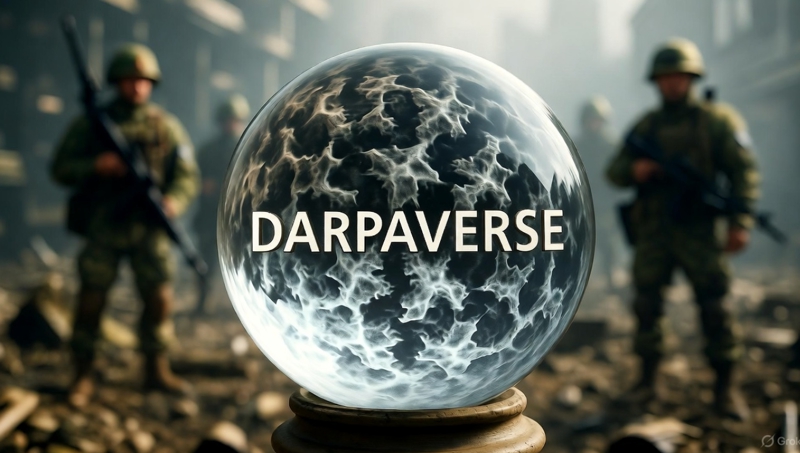DARPA is metaphorically manifesting Eris, the Greek goddess of discord and strife, by attempting to simulate, predict, and manipulate human behavior: perspective
DARPA is putting out a “program competition” to create a “DARPAVERSE” platform to model and simulate scenarios for optimizing military operations.
On October 10, 2025 the Defense Advanced Research Projects Agency (DARPA) opened the DARPAVERSE competition as a “Special Topic Area (STA)” for an already existing project called ERIS.
“DARPAVERSE: A unified platform enabling accelerated capability development, deployment, and optimal warfighter courses of action”
DARPA, DARPAVERSE Program Competition, October 2025

According to the DARPAVERSE announcement:
“The DARPAVERSE program aims to create a collaborative environment transforming how warfighters, analysts, and program managers interact with complex modeling systems, developing and deploying models of complex multi-domain problems iteratively to improve assumptions and solution quality with each iteration, approaching a Pareto-frontier of dominating solutions.”
The idea is to keep improving upon modeling systems to arrive at the best results with minimal downsides.
And the DARPAVERSE platform is intended to work extremely fast, under 24 hours.
“This program seeks to achieve a new, iterative capability to develop multi-domain models of concepts and scenarios in less than a day”
DARPA, DARPAVERSE Program Competition, October 2025
While the DARPAVERSE platform has to do with planning military operations, this particular STA doesn’t mention who the intended targets are specifically.
If we look through the lens of military intelligence operations, the intended targets could be civilian populations, foreign governments, criminal organizations, critical infrastructure, and so on.
“The end DARPAVERSE capability will seek to deliver a unified platform and immersive environment for rapid concept exploration to enable the warfighter, program manager, and analyst to ask iterative questions and to learn about problem spaces faster, converging on disruptive solutions”
DARPA, DARPAVERSE Program Competition, October 2025
Underlying the complexities of such an undertaking that fuses different types of models and simulation environment, the DARPAVERSE announcement highlights:
“DARPAVERSE challenges the current operating assumption that multi-domain models complex scenarios and concepts must be derived from stove-piped and monolithic simulation environments that result in models that are not maintainable, not factorable, and not composable with other models of differing provenance.
“DARPAVERSE plans to disrupt these assumptions by producing a new, open environment that utilizes automated reduced order model generation to accelerate existing models, derive models from data, and create new representations of those models that can be decomposed and recomposed to solve new problems and represent new assumptions as they arise.”
The DARPAVERSE challenge will take a look at three highly technical areas:
- Adaptive Software Repository
- Adaptive Co-Design and Orchestration
- Adaptive Definition and Vision
To see what those technical areas consist of, you can check out the specifics in the screenshots below.


As mentioned earlier, the DARPAVERSE STA is an add-on topic to the DARPA ERIS program.
In Greek mythology, Eris is the goddess of discord and strife.
But for DARPA, ERIS currently stands for Expedited Research Innovation System.
Previously, ERIS was known as Expedited Research Implementation Series.
And the ERIS Marketplace is a digital environment of post-competition, seven-minute video pitches designed to accelerate acquisition velocity and drive national security innovation.
You can see how this works in action in the time-stamped YouTube video below from DARPA TV.
The goals of ERIS are to establish a centralized location where DARPA can assess disruptive, cutting-edge technological solutions, and where industry, academia, and individual developers can promote their research, technologies, and related products and services to the government.
Currently, topic areas for ERIS include:
- Detecting and tracking elusive objects of interest across air, land, and space domains.
- Overcoming limitations of current sensing systems (size, weight, power, and cost (SWaPC), performance).
- Developing advanced technologies for improved resilience, efficiency, and effectiveness of strategi systems.
- This topic are supports technologies for critical infrastructure and military command-and-control systems (networks and applications across strategic, command, operational, and tactical edges).
- Advanced technologies for defense against potential chemical and biological threats, human-made or naturally occurring.
- This topic supports technologies for defense of humans and elements of the bioeconomy critical to national security, including agricultural crops, livestock, and biomanufacturing production organisms that deliver threat surveillance, threat detection, threat diagnosis, countermeasure design, countermeasure deployment, and threat attribution, to include simulation-based and experiment-based technologies.
- Advanced technologies for the improved resilience of US operations throughout the prepare, deployment, execute, and return cycle. This topic supports technologies for human health and performance optimization.
- This topic supports biotechnologies for production of supplies, in situ resource utilization, and creation of operational advantages, including in austere locations. This topic supports technologies in the convergence of Artificial Intelligence and Machine Learning (AI/ML) with chemistry and biology, including foundation models and data factories.
- Development of groundbreaking methods and metrology for complex, emergent, and adaptive systems, going beyond the limitations of current reductive scientific methods.
- Areas of interest include: developing metrology that accounts for quantum properties at scale; engineering desired material properties across various length scales; and designing adaptive and resilient human-AI ecosystems. Proposals should focus on developing scientific tools, theories, methods, and applied solutions. AI-only, data-driven approaches are out of scope.
ERIS and its DARPAVERSE challenge come on the heels of other DARPA research programs that look to simulate, model, predict, and manipulate human behavior.
For example, in May 2025, DARPA announced it was getting into the business of simulating disease outbreaks, including modeling interventions such as mass vaccination campaigns, lockdowns, and communication strategies via its “Advanced Disease Outbreak Simulation Capabilities” request for information (RFI).
“We are committed to developing advanced modeling capabilities to optimize response strategies and inform the next generation of (bio)technology innovations to protect the population from biological threats. We are particularly focused on understanding the complex interplay of factors that drive outbreak spread and evaluating the effectiveness of potential interventions“
DARPA, Advanced Disease Outbreak Simulation Capabilities RFI, May 2025

Prior to simulating disease outbreaks, DARPA issued an advanced research concept (ARC) opportunity in April 2025 called “Methodological Advancements for Generalizable Insights into Complex Systems (MAGICS),” which seeks new paradigms for modeling and predicting collective human behavior.
Nowhere in the MAGICS description did it mention modeling or predicting the behavior of “adversaries” as is DARPA’s custom.
Instead, it talked at length about “modeling human systems,” along with anticipating, predicting, understanding, and forecasting “collective human behavior” and “complex social phenomena” derived from “sociotechnical data sets.”
“The MAGICS ARC calls for paradigm-shifting approaches for modeling complex, dynamic systems for predicting collective human behavior”
DARPA, MAGICS ARC, April 2025

And before ERIS, the DARPAVERSE, and MAGICS, DARPA put out a special notice in December 2024 for a research program called “Theory of Mind,” with the goal of developing “new capabilities to enable national security decisionmakers to optimize strategies for deterring or incentivizing actions by adversaries.”
According to the special notice, “The program will seek to combine algorithms with human expertise to explore, in a modeling and simulation environment, potential courses of action in national security scenarios with far greater breadth and efficiency than is currently possible.
“This would provide decisionmakers with more options for incentive frameworks while preventing unwanted escalation.”
“The goal of an upcoming program will be to develop an algorithmic theory of mind to model adversaries’ situational awareness and predict future behavior […] The program will seek not only to understand an actor’s current strategy but also to find a decomposed version of the strategy into relevant basis vectors to track strategy changes under non-stationary assumptions”
DARPA, “Theory of Mind” Special Notice, December 2024

DARPA’s “Theory of Mind” program was later named “Kallisti” — a term associated with the mythological “Apple of Discord” and the start of the Trojan War.
According to the Kallisti program description, “The program will seek not only to understand an actor’s current strategy but also to find a decomposed version of the strategy into relevant basis vectors to track strategy changes under non-stationary assumptions.”
The program looks “to combine algorithms with human expertise to explore, in a modeling and simulation environment, potential courses of action in national security scenarios with far greater breadth and efficiency than is currently possible.”
“The objective of the Kallisti program is to develop an algorithmic model of adversarial platform situational awareness and predict future behavior […] Kallisti seeks to provide decision-makers with more options for incentive frameworks while preventing unwanted escalation“
DARPA, Kallisti Program, January 2025

The word Kallisti appears in Greek mythology when the goddess of discord and strife, Eris, was furious about not being invited to a wedding.
She wrote the word Kallisti, meaning “to the fairest,” or “for the most beautiful,” on a golden apple, which she tossed into the wedding banquet.
Three goddesses claimed to be the fairest, and thus the rightful recipient of this golden “Apple of Discord:”
- Hera: Goddess of marriage and family
- Athena: Goddess of warfare and wisdom
- Aphrodite: Goddess of love and beauty
Zeus gave the decision on who was the fairest to Prince Paris of Troy in what was called the “Judgement of Paris.”
To persuade Paris’s decision, Hera offered him riches and power, Athena offered him wisdom and success in battle, and Aphrodite offered him the most beautiful woman in the world, Helen, who was already married to King Menelaus of Sparta.
Paris chose Aphrodite as the fairest, and so with Aphrodite’s blessing he abducted Helen, which then sparked the Trojan War.
Eris was delighted at the chaos she had wrought.
She created mayhem at a wedding, caused strife among the goddesses, and launched one of the greatest wars in myth and legend.
While the Kallisti-inscribed mythological apple was meant to sow mayhem, DARPA’s Kallisti program seeks to prevent “unwanted escalation,” but are we seeing the makings of another Trojan Horse scenario?
Here we see the themes behind DARPA’s ERIS, DARPAVERSE, MAGICS, Theory of Mind, and KALLISTI come full circle.
Through these marketplaces, research programs, special notices, and requests for information, DARPA is metaphorically manifesting the Greek goddess of discord and strife by attempting to simulate, model, predict, and manipulate human behavior in order to optimize military operations.
Once upon a time, DARPA brought us the ARPANET, which was the precursor to the Internet.
What will the DARPAVERSE bring us?
Image Source: AI generated with Grok












